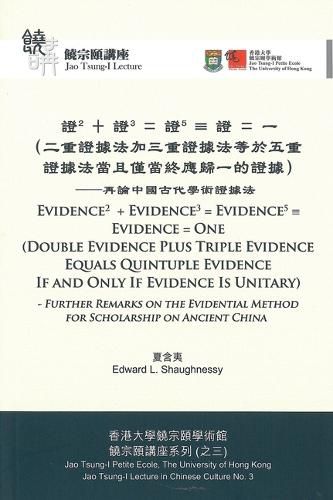Readings Newsletter
Become a Readings Member to make your shopping experience even easier.
Sign in or sign up for free!
You’re not far away from qualifying for FREE standard shipping within Australia
You’ve qualified for FREE standard shipping within Australia
The cart is loading…






Throughout the twentieth century, the Double Evidence Method advocated by Wang Guowei was the most important research method for the cultural history of ancient China. However, in 1982, Jao Tsung-i proposed a Triple Evidence Method, adding material culture to the paper sources and underground sources of Wang Guowei. In 2003, Jao again discussed scholarly methods, and added two more indirect types of evidence anthropological sources and ancient historical sources of other countries. What constitutes evidence, how to use evidence, and how to decide the weight to give to evidence are the first problems encountered by historians. The views of Wang Guowei and Jao Tsung-i can be considered as the mainstream of contemporary history, and in The Cambridge History of Ancient China, of which Edward L. Shaughnessy was editor, the editors adopted this methodology as the basic structure of the book. Nevertheless, after the book was published, the editors discovered that not all scholars accept this viewpoint. Two book reviews were published raising pointed criticisms from two different standpoints one said that the editors had under-emphasized traditional Chinese literature, while the other said that they had over-emphasized the historicity of traditional Chinese literature, and because of this their results were unscientific and non-objective. In this book, Shaughnessy first provided a brief overview of twentieth century viewpoints regarding historical research methods, and then gave a more detailed discussion of the editorial work on and readers’ responses to The Cambridge History of Ancient China.
$9.00 standard shipping within Australia
FREE standard shipping within Australia for orders over $100.00
Express & International shipping calculated at checkout
Throughout the twentieth century, the Double Evidence Method advocated by Wang Guowei was the most important research method for the cultural history of ancient China. However, in 1982, Jao Tsung-i proposed a Triple Evidence Method, adding material culture to the paper sources and underground sources of Wang Guowei. In 2003, Jao again discussed scholarly methods, and added two more indirect types of evidence anthropological sources and ancient historical sources of other countries. What constitutes evidence, how to use evidence, and how to decide the weight to give to evidence are the first problems encountered by historians. The views of Wang Guowei and Jao Tsung-i can be considered as the mainstream of contemporary history, and in The Cambridge History of Ancient China, of which Edward L. Shaughnessy was editor, the editors adopted this methodology as the basic structure of the book. Nevertheless, after the book was published, the editors discovered that not all scholars accept this viewpoint. Two book reviews were published raising pointed criticisms from two different standpoints one said that the editors had under-emphasized traditional Chinese literature, while the other said that they had over-emphasized the historicity of traditional Chinese literature, and because of this their results were unscientific and non-objective. In this book, Shaughnessy first provided a brief overview of twentieth century viewpoints regarding historical research methods, and then gave a more detailed discussion of the editorial work on and readers’ responses to The Cambridge History of Ancient China.